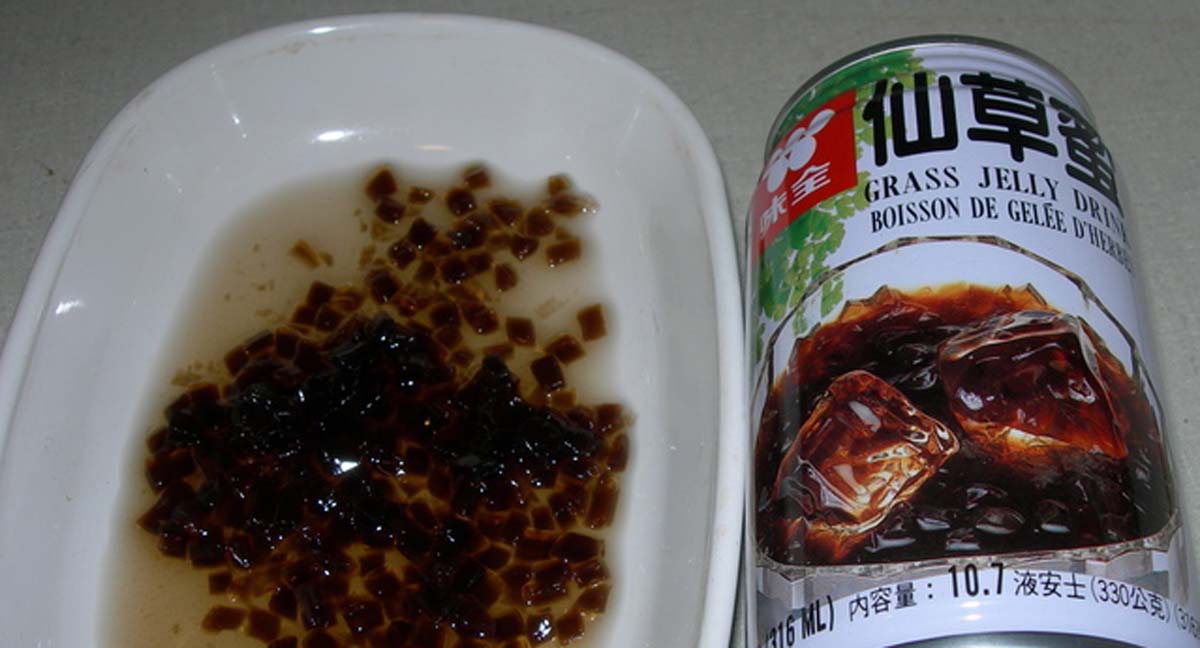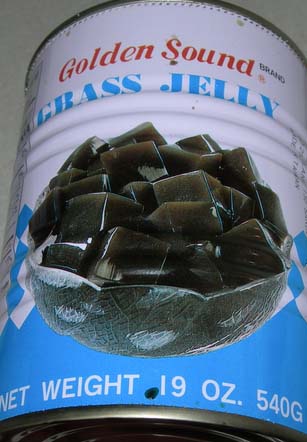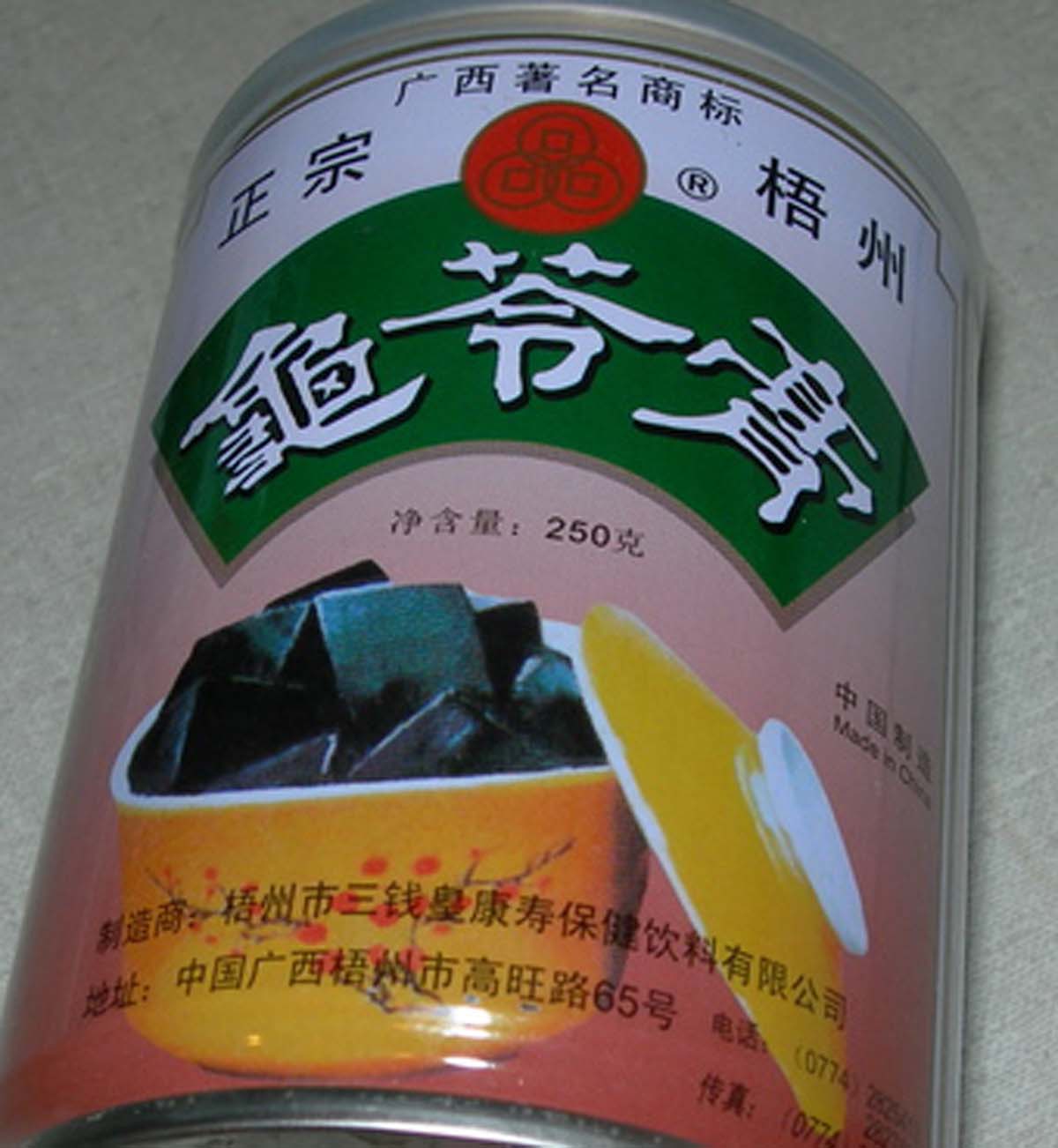
| What is Flavor and Fortune? |
| How do I subscribe? |
| How do I get past issues? |
| How do I advertise? |
| How do I contact the editor? |
Read 12994967 times
Connect me to:
| Home |
| Articles |
| Book reviews |
| Letters to the Editor |
| Newmans News and Notes |
| Recipes |
| Restaurant reviews |
| Article Index (all years, slow) |
| List of Article Years |
| Article Index (2025) |
| Article Index (last 2 years) |
| Things others say |
| Related Links |
| Log In... |
| Authors |
| Categories & Topics |
Black Grass Jelly Revisited
| by Jacqueline M. Newman |
Unusual Ingredients
Spring Volume: 2007 Issue: 14(1) page(s): 22 and 23
A reader's comments led to much thought and more investigation about black grass jelly. Was our knowledge correct? At first we agreed we were wrong, but further research and additional conversations indicated we needed to share more with all our readers. Before we do, thanks to all who wrote, you encouraged us to dig deeper.
Black grass jelly or any grass jelly can be and is different things to different people. One gentleman believes our sources confuse black grass jelly, called xian cao, with what he calls "jelly fig jelly or yu." He says the latter is "often clear yellow or golden in color and made by rubbing the seeds of the jelly fig, Ficus awkeotsang Makino together under water." He goes on to say "this releases gelling mucilage....and it can be flavored with lemon juice and sugar or honey." He tells us that "xian cau is the black gel made by boiling Mesona procumbens or Mesona chinensis with potash (chemically known as potassium carbonate)."
 We learn from him and others, that black grass jelly or xian cao comes as a liquid in cans available in most Asian markets as seen here to the left, and as a solid gel seen below. We set out to buy this liquid and discover the drink (see the picture of can and contents on this page) and the solid jelly. We do know cubes and rolls of black jelly and sometimes order them with our dim sum. The small cubes in the beverage look different and they sink to the bottom of the can. The can, when inverted or liquid sucked out with a straw, includes these cubes that provide textural contrast close to that in bubble tea. We disagree because we find them tiny and softer than an any boba or bubble tea we ever drank.
We learn from him and others, that black grass jelly or xian cao comes as a liquid in cans available in most Asian markets as seen here to the left, and as a solid gel seen below. We set out to buy this liquid and discover the drink (see the picture of can and contents on this page) and the solid jelly. We do know cubes and rolls of black jelly and sometimes order them with our dim sum. The small cubes in the beverage look different and they sink to the bottom of the can. The can, when inverted or liquid sucked out with a straw, includes these cubes that provide textural contrast close to that in bubble tea. We disagree because we find them tiny and softer than an any boba or bubble tea we ever drank.
We consult additional experts. In the The Encyclopedia of Asian Food by Charmaine Solomon (Boston MA: Periplus Editions, 1998), she says grass jelly drink is "sweet, almost malty tasting...and.....looks like flat cola." She goes on to say "some brands include soft jelly-like bits made by thickening the grass liquor with cornflour." Steve Facciola, in Cornucopia II (Vista CA: Kampong Publications, 1998), writes about the plants used to make these solid and liquid foods.
 Solomon gives a recipe to use the black jelly found in cans that is the texture of cranberry sauce jelly. She recommends grating it into fine long strands or cutting into mouth-sized cubes. We cut both the solid black and green can contents and ready them for use. One can, and we did, put a couple of spoonfuls in each glass. One should add rock sugar syrup and some cold water and eat or drink them. Solomon goes on to say, the drink should be cool.
Solomon gives a recipe to use the black jelly found in cans that is the texture of cranberry sauce jelly. She recommends grating it into fine long strands or cutting into mouth-sized cubes. We cut both the solid black and green can contents and ready them for use. One can, and we did, put a couple of spoonfuls in each glass. One should add rock sugar syrup and some cold water and eat or drink them. Solomon goes on to say, the drink should be cool.
From other experts, we had learn that page 31 in the Fall issue of Flavor and Fortune's Volume 13(2) is not in error, just insufficient. Why, because there are several plant sources for this food and the jelly can look different as can be seen in the pictures of their contents.
The most common plant for the jelly, Ficus pumila, is a climbing fig vine. Not all plants used for these jellies are. Ficus pumila var. Awkeotsang called aiyuzu, and Ficus sycomorus, and other Ficus variants make different kinds and colors of jelly. They can be green or black, as the ones we found, or they can make yellow jelly. It depends on which one is used and how and with what it is flavored. The light colored green jellies are often mixed with juice from the pandan leaf. Yellow jellies can have chrysanthemum added, and white ones might add soy milk. The black ones can be natural or with added herbs; and they taste the most medicinal. And, there are other ones with yet different colors.
In addition to jellies made with Ficus varieties, grass jelly can be made from one or another herb in the Moraceae or Lamiaceae families. Mesona chinensis, is used in other sweet drinks, some firm, others not. Known in China and other Asian countries, were that not enough, the Chinese also use the leaves of these plants as vegetables, they cook their seeds, and they consume their fruits.
 Making grass jelly, means preparing juice from the fruits or the seeds. If using the fruit, extract juice from very ripe specimens, wash, and put them in a porous bag or cloth. Squeeze out the liquid and boil it once or twice. When cool it becomes gelatinous. If using seeds, called 'jelly seeds' or other parts of the plant and prepare them as indicated by Mr. Jeffrey in that earlier Flavor and Fortune issue. Both of these can be used in the recipes below. The cooked juice is called pai liang fen. Water and selected flavorings, other syrups, honey, and/or other sugars can be added to either cooked liquid.
Making grass jelly, means preparing juice from the fruits or the seeds. If using the fruit, extract juice from very ripe specimens, wash, and put them in a porous bag or cloth. Squeeze out the liquid and boil it once or twice. When cool it becomes gelatinous. If using seeds, called 'jelly seeds' or other parts of the plant and prepare them as indicated by Mr. Jeffrey in that earlier Flavor and Fortune issue. Both of these can be used in the recipes below. The cooked juice is called pai liang fen. Water and selected flavorings, other syrups, honey, and/or other sugars can be added to either cooked liquid.
These plants are native to China, Japan, and Vietnam. They are made into jellies in each of these countries. They are also grown in Africa and North and South America and perhaps elsewhere. In every country, the cooked liquid can have added thickening using cornstarch, tapioca, or another starch. The products almost always are in some gelatinous form. Cassava is the main ingredient in boba or bubble tea. It is more firm after cooking than are things made from the Ficus plants.
Virtually all the folks we consulted could not think of nor could they provide a recipe. They all knew the beverage, but did not agree as to how it was made or what it was made from. Now we understand the confusion. Most could not remember eating it mixed with another food or even having it at home or in a restaurant. When wee mentioned the black jelly rolls found in dim sum eateries, their eyes lit up in agreement but did admit not knowing it was related to green grass jelly.
One web site we visited said black grass jelly is cooked in a casserole with chicken, Chinese dates, mushrooms, and Chinese parsley. They provide no exact ingredient list nor any specific amounts. Another site pictures black grass jelly in a bowl with soy milk and pieces of mango. Seek them out for yourselves at the following sites: www.waynesword.palomar.edu/ecoph37.htm or www.en.wikopedia.org/wiki/Image:Grass_Jelly-1.JPG or www.everyting2.com/index.pl?node_id=1339345 or www.ihtthaiday.com/IHT/viewNews.aspx?NewsID=9490000084284 None have a single recipe.
Our hundreds upon hundreds of cookbook had only two recipes. Both simply called for 'black grass' for jelly. We found no raw product to purchase and prepare. Therefore, we have not tested the recipes that follow. The first one is from in Kitty Choi's Asian Snacks Cooking Course (Hong Kong: Food Paradise Publishing Company, 2005). The second is from Youji Chen's Classic Snacks (Hong Kong: Wan Li Book Company, 2004). Both recipes are rewritten below in this magazine's style. Neither has nutrient analysis because the program we use does not have any for grass jelly in any form.
| Grass Jelly Choi |
|---|
1/2 cup Mesona chinensis(an herb mentioned in the Grass Jelly article) 2 Tablespoons alkaline water (available in Asian markets) 1/2 pound cornstarch Preparation: 1. Wash the herb thoroughly and put in to a pot with four and a half quarts of water and the alkaline water. Bring this to the boil, reduce heat and simmer for two hours, then cool. 2. Rub the herb vigorously so that gel is extracted; save it, then boil the remaining water and the extract for half an hour. Repeat one more time, and after rubbing, filter out any solids left in the pot. About twelve cups of liquid will remain. 3. Stir in cornstarch and two and a half cups of cold water. Stir quickly and then bring almost to the boil, Pour this into a bowl or pan and chill. When solidified, dice and serve with a sugar syrup, if desired. |
| Grass Jelly Chen |
|---|
4 Tablespoons rice flour 6 Tablespoons black grass for jelly 2 and 1/2 teaspoons bottled alkaline water 4 Tablespoons bean flour Preparation: 1. Grind rice with a little water to make a slurry. Pass through a cloth to remove all particles, then set aside. 2. Put nine cups of cold water in a non-metal pot. Add black grass jelly and the alkaline water and simmer on high heat for an hour. Remove from heat an allow to cool, then rub in pan to extract sticky stuff from the grass. Pout this and the liquid back into the pot and cook twenty minutes more. Repeat the rubbing, and boil again and rub once more. Strain and discard solids, strain and boil one more time. 3. Put rice liquid and bean flour in a bowl or pan and stir well, then pour into the boiling grass jelly liquid, and stir well, and while stirring, pour into a pudding pan and allow to cool and solidify. Chill in refrigerator and cut as needed before serving. |

Copyright © 1994-2025 by ISACC, all rights reserved
Address
3 Jefferson Ferry Drive
S. Setauket NY 11720